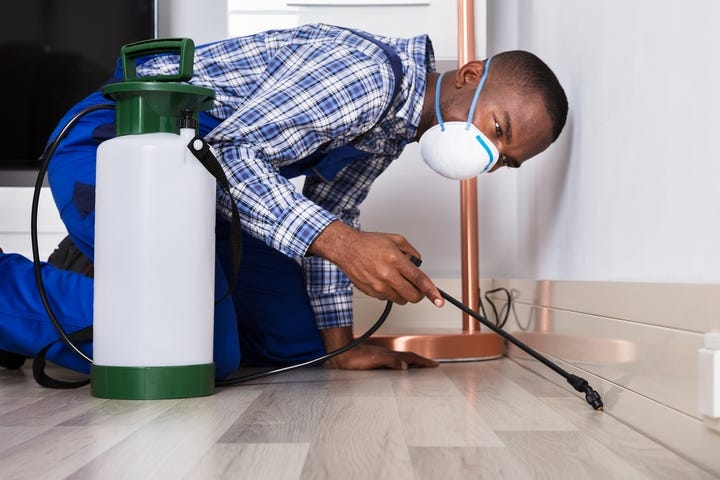Professional Bed Bug Exterminator: Rest Easy Understanding Your Home is Bug-Free!
Professional Bed Bug Exterminator: Rest Easy Understanding Your Home is Bug-Free!
Blog Article
Specialist Insect Control Techniques for Long-Term Results
In the realm of insect control, attaining continual efficiency and long-lasting results needs a thorough strategy that goes beyond mere elimination. Professional bug control strategies envelop a comprehensive approach that starts with a thorough assessment and assessment, adhered to by precise parasite identification to comprehend their behavior patterns. The application of Integrated Bug Monitoring (IPM) principles, paired with eco-conscious therapies, creates the keystone of sustainable insect obliteration. The true examination lies in the continuous surveillance and upkeep of the treated areas, guaranteeing a pest-free atmosphere for the direct future. By delving into the details of these methods, a deeper understanding of professional bug control methods for sustaining outcomes emerges.
Evaluation and Evaluation
Upon getting in a building for insect control services, the first step is a comprehensive evaluation and assessment to identify the level of the problem and figure out one of the most reliable therapy plan. Specialist pest control technicians are trained to meticulously take a look at the facilities, searching for indications of pest task such as droppings, munch marks, nests, or any architectural damages. They will certainly also assess the problems that might be attracting bugs, such as food sources, water leaks, or entry factors.

Bug Recognition and Actions

Additionally, comprehending the actions of the identified parasite is vital to implementing effective control steps. Recognizing where parasites nest, what they feed on, and their activity patterns can aid pest control specialists devise strategies to eradicate them successfully.
Integrated Pest Management (IPM)
Integrated Bug Monitoring (IPM) methods combine several strategies to control and avoid insect invasions in a lasting and eco-friendly fashion. bed bug heat treatment. By integrating techniques such as organic control, habitat adjustment, adjustment of cultural techniques, and using resistant selections, IPM aims to lessen making use of chemical pesticides
One of the key principles of IPM is the emphasis on prevention. This positive method includes tracking pest populaces frequently to find any prospective issues before they intensify. By recognizing parasite issues beforehand, pest control actions can be carried out quickly and effectively.
Moreover, IPM promotes the use of safe bug control methods whenever feasible. This can consist of using all-natural predators of the pests, introducing valuable insects, or utilizing pheromones to interrupt breeding patterns. By reducing reliance on chemical pesticides, IPM not just secures the setting yet also aids maintain a balance in the environment.
Environmentally-Friendly Therapies
Carrying out eco-conscious approaches in pest control procedures can successfully address infestations while focusing on ecological sustainability. Environmentally-friendly treatments concentrate on lessening the impact of bug control approaches on environments, non-target microorganisms, and human health. These techniques typically entail the use of all-natural killers, such as ladybugs or nematodes, to manage pest populations, lowering the requirement for chemical interventions. In addition, strategies like habitat manipulation, such as changing wetness levels or eliminating food resources, can help discourage bugs without using dangerous substances.
Another secret facet of environmentally-friendly therapies is making use of organic and naturally degradable items that break down quickly without leaving harmful deposits in the setting. Herb pesticides originated from plants like chrysanthemums or neem provide effective insect control while presenting very little danger to non-target types. Furthermore, employing methods like warm therapies or scent traps can target specific bugs with precision, decreasing the bed bug heat treatment overall ecological impact of bug control practices.
Recurring Monitoring and Upkeep
Normal evaluations by skilled specialists are necessary to determine any type of indicators of parasite activity, evaluate the efficiency of previous treatments, and make modifications to the parasite control strategy as required. By keeping an eye on bug populaces over time, pest control professionals can track patterns, prepare for potential problems, and apply preventive actions to minimize the risk of future invasions.
Along with tracking, upkeep practices are essential for long-lasting pest control success. This consists of carrying out correct sanitation actions to get rid of potential food and water sources for bugs, sealing off access factors to stop bugs from getting in the facilities, and addressing any kind of architectural issues that might promote pest problems (exterminator near me). By integrating recurring surveillance and maintenance right into an incorporated insect monitoring approach, services can ensure a pest-free atmosphere and secure their residential property versus costly damages and health risks
Final Thought
To conclude, using professional parasite control strategies such as detailed inspection and evaluation, exact bug identification and understanding of their behavior, incorporated insect management techniques, environmentally-friendly therapies, and continuous monitoring and upkeep are important for accomplishing lasting cause parasite control. By carrying out these approaches, people can effectively take care of insect invasions and preserve a pest-free setting in a lasting fashion.
Report this page